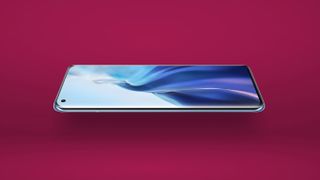Xiaomi Mi 11 is first with Snapdgragon 888 — and surprise weapon against Galaxy S21
Top Android devices like the Galaxy S21 will face a tough competitor in the Xiaomi Mi 11

The first phone to feature Qualcomm’s Snapdragon 888 chip has arrived. Xiaomi has taken the wraps off the Xiaomi Mi 11, its latest flagship, giving us an early look at what we can expect from high-end smartphones in 2021.
The Xiaomi Mi 11 will be sold only in China at first, but when it does land it figures to pose a formidable challenge to the new Samsung Galaxy S21 and the best smartphones.
- The best Android phones available now
- Snapdragon 888 benchmarks: Galaxy S21 should give the iPhone 12 a fight
- Plus: Samsung Galaxy S21 pre-order reservations are now live
Screen size: 6.81-inch AMOLED, 120Hz
CPU: Snapdragon 888
RAM: 8GB, 12GB
Storage: 128GB, 256GB
Rear cameras: 108MP (f/1.85) main; 13MP (f/2.4) ultrawide; 5MP (f/2.4) telephoto macro
Front camera: 20MP (f/2.4)
Battery size: 4,600 mAh
Size: 6.5 x 2.9 x 0.32 inches
Weight: 6.9 ounces
We already knew that the Xiaomi Mi 11 was going to be the first phone to debut with Qualcomm’s latest Snapdragon chipset — Xiaomi said as much when the Snapdragon 888 was unveiled earlier this month. But that chip is headed to other top phones in 2021, including the Galaxy S21. While no one’s confirmed that yet, Samsung typically uses the top Qualcomm chip in its Galaxy S models released in the U.S., and the Galaxy S21 is likely to be no exception.
There’s more to keep an eye on with the Xiaomi Mi 11 than just its chipset, though. The Mi 11 will feature a 6.81-inch AMOLED display, with 1440p resolution and 120Hz refresh rate. That refresh rate matches what Samsung currently offers in its top phones, and possibly the Galaxy S21 too. However, rumors point to the 6.2-inch Galaxy S21 and 6.7-inch Galaxy S21 Plus both offering FHD+ resolutions, giving Xiaomi’s phone a potential edge.
The Xiaomi Mi 11 also features a in-screen fingerprint reader, which is expected from Android flagship these days. But it pulls off a pretty cool trick. This sensor can also read your heart rate. We've seen IR sensors pull this off on the back of phones, but it's first time we've seen a heart rate sensor built into the display itself.
The Xiaomi Mi 11 is also a slimmer, thinner device than its predecessor — nearly a millimeter thinner, in fact, at 8.06mm, though the Mi 11 is taller to accommodate a larger screen. The front of the phone is nearly bezel-free — a direction Samsung could take the Galaxy S21 in, if the phone maker adopts a rumored "blade bezel" design, which uses thin, flat edges to minimize the bezel.

The Mi 11's camera array has been completely redesigned from previous Xiaomi flagships. It features a sleek, vertical arrangement with a rounded square element that includes three camera modules inside. At its launch event in China, Xiaomi didn't go into much detail about what to expect from the camera, other than the fact that the main module is 108MP, much like the one featured on the Mi 10. However, its aperture is at f/1.89 instead of 1.69, while a 13MP ultrawide angle camera and 5MP telephoto lens make up the rest of the rear cameras. It's also capable of a 2x optical zoom.
Sign up to get the BEST of Tom’s Guide direct to your inbox.
Upgrade your life with a daily dose of the biggest tech news, lifestyle hacks and our curated analysis. Be the first to know about cutting-edge gadgets and the hottest deals.
It sounds like the Mi 11 could challenge the camera array on the Galaxy S21 Ultra, Samsung’s high-end model which will also be highlighted by a 108MP main sensor. Samsung’s phone could feature two telephoto lenses, though. The cameras on the Galaxy S21 and Galaxy S21 Plus are expected to include a 12MP main camera, through the telephoto lens could deliver a 3x optical zoom, according to the latest leaked Galaxy S21 specs.
Finally, the Mi 11 will feature a massive 4,600 mAh battery, with 55W charging and 50W wireless charging support. The Galaxy S21, in contrast, is said to feature a 4,000 mAh battery, while the S21 Plus and S21 Ultra will reportedly feature 4,800 mAh and 5,000 mAh power packs respectively.
Xiaomi’s phone will ship without a charger, following a trend Apple first started with the iPhone 12 this past fall. Reportedly, the Galaxy S21 will follow suit when it arrives sans charger in a month. Xiaomi CEO Lei Jun cited environmental concerns as the reason behind the decision, echoing Apple’s reasoning. This about-face comes just a month after Xiaomi posted a message to its social media account mocking Apple for doing the same thing.
The Xiaomi Mi 11 costs 3,999 yuan, about the equivalent of $612 under current conversion rates. With top Android flagships generally flirting with $1,000 price tags, that’s quite a contrast for Xiaomi’s latest phone.
Brittany Vincent has been covering video games and tech for over 13 years for publications including Tom's Guide, MTV, Rolling Stone, CNN, Popular Science, Playboy, IGN, GamesRadar, Polygon, Kotaku, Maxim, and more. She's also appeared as a panelist at video game conventions like PAX East and PAX West and has coordinated social media for companies like CNET. When she's not writing or gaming, she's looking for the next great visual novel in the vein of Saya no Uta. You can follow her on Twitter @MolotovCupcake.

